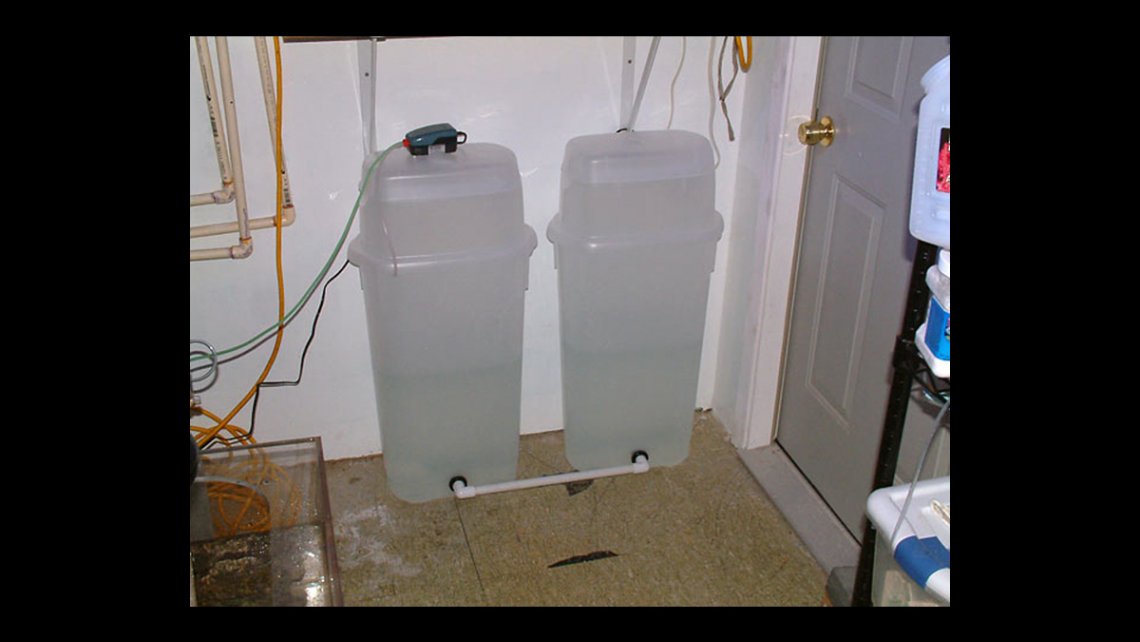280g Reef - Automatic top off
One question I'm asked quite often is how does an "auto top-top" work. This is a method that can add more freshwater to your aquarium automatically. The benefit of this is that your tank will remain more stable as salinity remains at the same level because new water is replacing what has evaporated.
Others set up a system so that if they go on a short vacation, the tank will be taken care of.
I'm going to show you what I've been using for three years or longer with no problems. Needless to say, there are many other methods that can be safer or more complex depending on your needs. This system can be built for about $20 to $30 depending on what you own already. Please read through this completely, perhaps even twice. 
I use an electrical float switch that can be purchased online for $6 plus shipping. You might order two, since they are cheap and if it fails or you ruin it, you'll have another.
Parts List:
| float switch 6' extension cord relay |
relay project box 2 wire nuts some flexible tubing |
small powerhead water holding container Screws |
Take the extension cord, and at the middle, carefully separate the two wires. You can do this by cutting between the two with a razor blade / utility knife. Cut about 4". Now cut one wire in half. The other wire is left intact. It should not matter which wire you cut. (I shouldn't have to say this, but do not cut the cord if it is plugged in! If you get shocked or electrocuted, don't blame me.)
Strip off a little bit of the plastic shielding on each end from the wire you cut in half.
Thread your float switch through whatever bracket you've designed, and then use one wire nut to connect the red wire from the float switch to one of the wires that you bared. Now connect the other red wire to the other wire. Make sure the wire nuts are tight and you can't tug any wires loose. Now take a baggie and put it over the wiring you spliced and wrap it with electrical tape or secure it with a zip tie. This makes the connection water resistant, as spashes and accidents occur. DONE! Note: The previous paragraph worked for years, but it's not a safe method so I crossed it out. Read on:
Wire that extension cord to the relay's main power terminals, then wire the float switch's two wires to the lower voltage screws. Close and seal the project box, screwing it to a safe dry area. Tons of pictures here showing how to do this project: http://melevsreef.com/articles/installing-the-aquahub-ato-kit
Install the float switch in your sump (or your display tank if you don't use a sump) in a spot where it will not be knocked loose. This is extremely important. It should be secured in a permanent way (example), and you should take care to prevent anything from touching it such as a wandering snail. It can snack on some nearby algae and then park there while your sump overflows. If you put the float where you have snails, you might have to create a snail guard. The float's location will be the water level in your sump or tank, so you'll want to figure that out before you secure the bracket.
Insert some flexible tubing into the outlet of the small powerhead. You'll have to find tubing and a pump that match, but it shouldn't be hard to find something that will work. Remember, the pump can be very small because it doesn't need to be strong.
Plug the powerhead into the end of the extension cord, and put it in your container of water.
Position the other end of tubing in your sump or in your tank, but affix it so it can't accidentally move. It should pour water into your system, not the nearby floor. The tubing must remain above water level, so that it will pour into your system. If it becomes submerged, it will create a siphon which will either drain all your freshwtaer into your system, or drain the water from your tank inot the container. Just keep it 1" off the water and you'll be fine.
Plug in the extension cord of your float switch assembly into a power source. Test the float by pressing it down. The powerhead should turn on, and when you lift the float, it will shut off.
How does it work? When the float switch drops down, it completes the circuit and the outlet on the end of the power cord is now live and will run anything you've plugged into it. As a kid, we always tested if an outlet worked with a hair dryer. So that is what I did with my first float switch, and immediately burned it up. 1500w of power is too much for these switches, so if you feel the need to test it, use a 100w lamp or something like a clock radio. But I digress... When the float switch rises, the power cord goes dead.
Here are some visuals of the original install
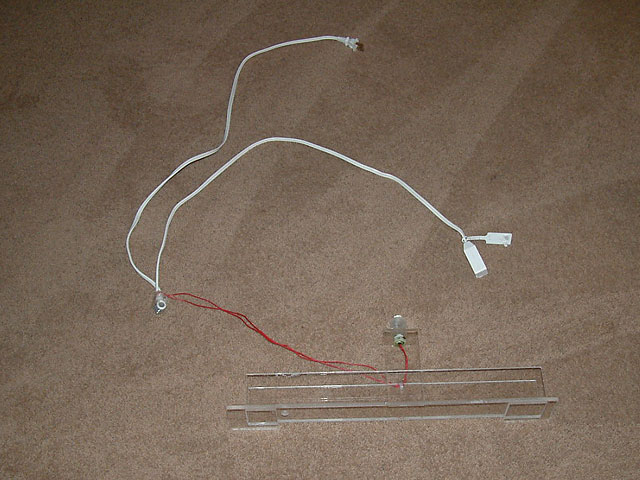
First of all, here is the entire setup ready to install. The acrylic bracket was made to span my glass sump, because I couldn't glue a bracket to the glass as the system was running. I know it's garrish looking, but it did the job.
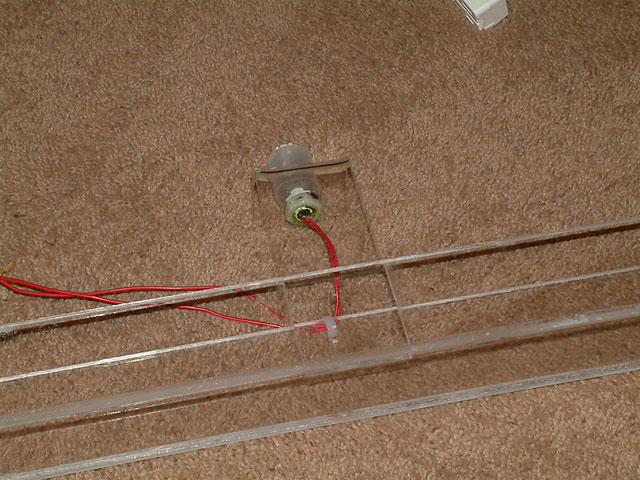
This is the float switch, screwed with the retaining nut to the brace.
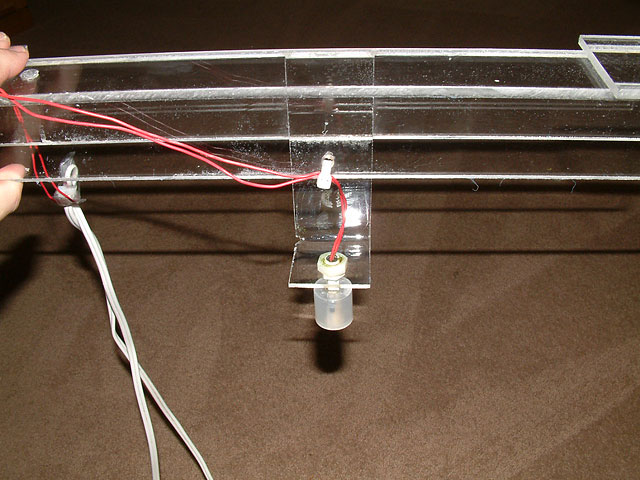
This is how it will sit in the sump, in the return section. This is the area where evaporation becomes apparent.
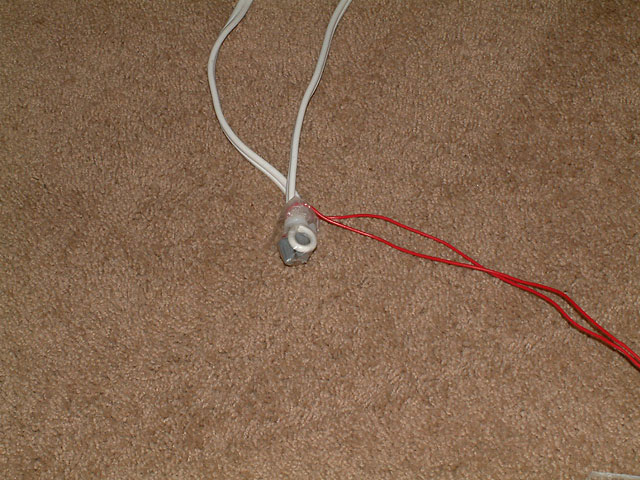
This is the cord where the float switch is spliced in. You can see the one (white) wire that was not cut.
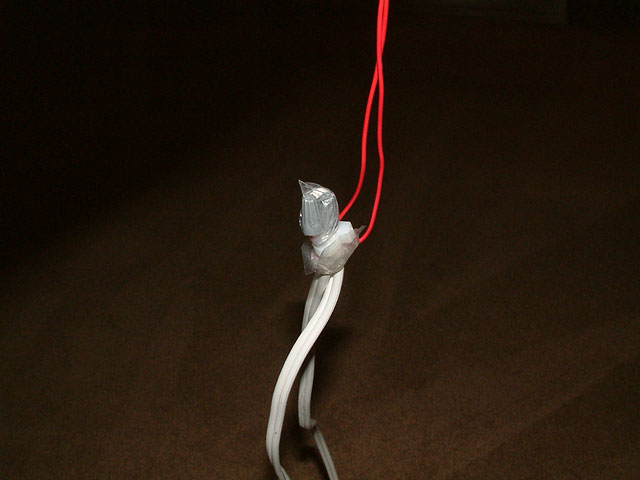
When my system is in place, I make sure the wiring is water-resistant, so I wrapped it and point it upward so water runs down the bag and down the wires. It is like a little umbrella to avoid water getting into the wire nuts.
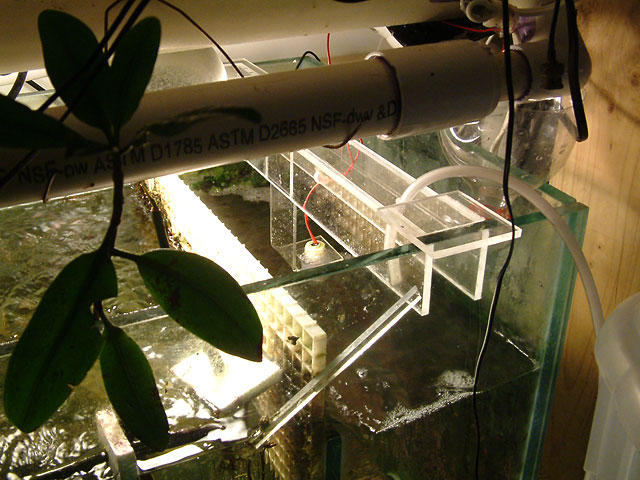
The bracket is in place in my sump. The white tubing comes from my top off container and pours into the return section.
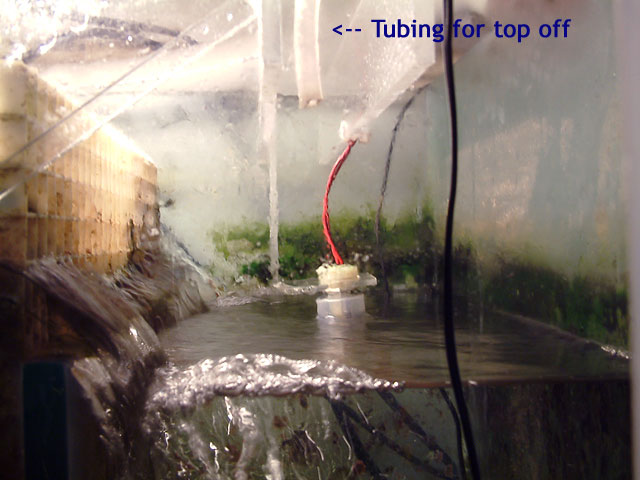
Side view. Currently the float is UP, and no water is added. As evaporation occurs, the float will drop.
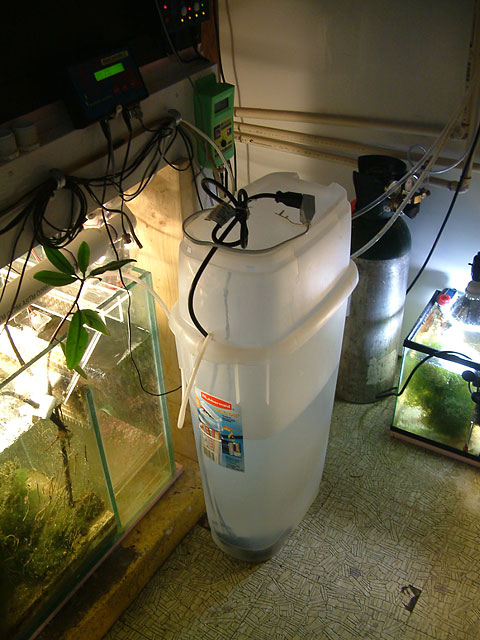
This container is designed to hold wrapping paper. It cost less than $10 at Walmart, and fits in narrow spaces. It can hold 10g of water. For my system, I can fill it up and it will top off my 280g reef for two or three days. When I used the same system on my 29g, it would last 5 days.
I discovered that the water in your top off container should not be taller than your sump. If it is, once the pump turns off, gravity will continue to drain water until the water in the container and the water in the sump match.
I hope that this information helps you understand how it works and how it can be set up. It really isn't difficult or complicated, and the suggestions I made will help you avoid some problem that may occur. Try to plan well and you'll avoid accidents later.
Are there alternatives? You can set up a system that is based on gravity with a float valve. In this case, you'll need the container of water to be on a stand so that it is higher than the sump. Instead of a float switch, use a float valve. Install a drain (bulkhead) in your container and run tubing from the container to the float valve. When the valve drops, water is allowed to drain from the container into the sump. Once the water level rises again, so does the float and the water is stopped until more is needed.
Other methods use dosing pumps, or inverting a bottle or jug of water into the sump like a water cooler bottle. As it is needed, some water pours out. Another method uses air to pressurize a sealed container filled with water, forcing water out and into the tank via thin tubing. Whatever method you choose, test and think it through so it will be reliable and trouble-free!
12/08/05: I replaced my top off container with something a little more sleek that hugs the wall, and also allows more stored water volume. I needed two 1/2" bulkheads, some PVC, and a new pump. See below.
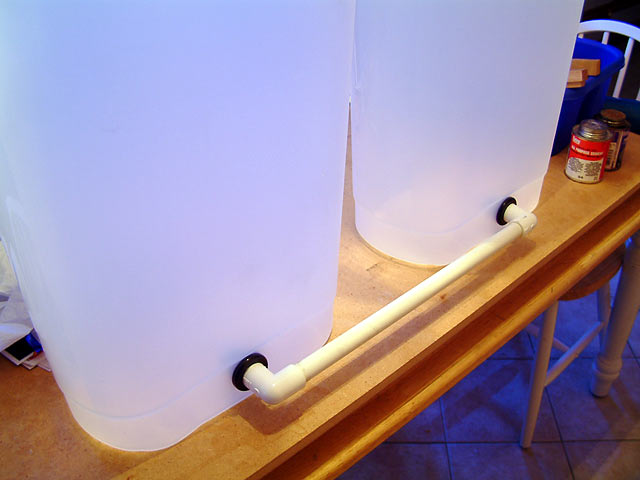
These connections were glued permanently, as I didn't want to deal with any leaks. Each container holds 10g, so I can have 20g of RO/DI water available. The water level in the two containers is always the same height, and lower gradually as top off is needed.
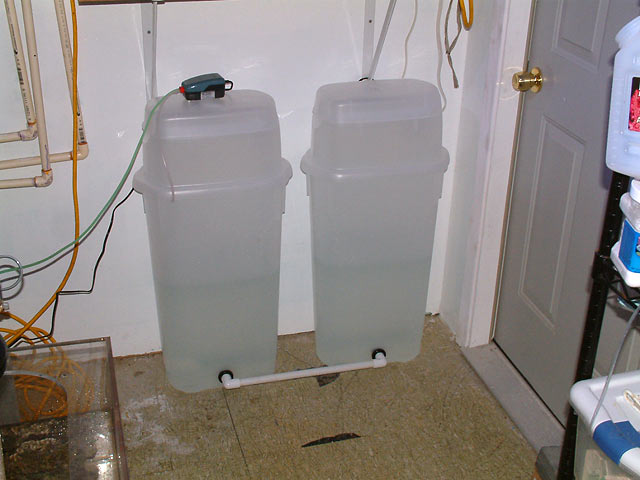
The Aqua Lifter is a small pump that sucks water up from the bottom of the container, and pumps it into the sump via the green tubing. It uses 3 watts of power, and can move up to 3g of water per hour. It runs silently, like an air pump.
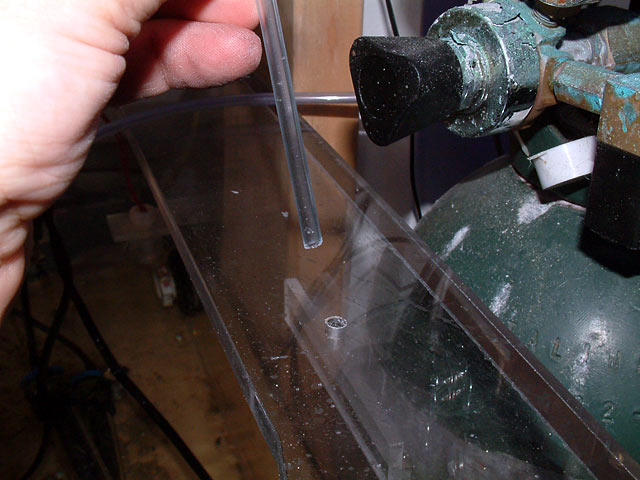
I made the end connection easy to remove, so that I can move it out of my way when I need to access the power panel or return pump in the rear corner of the fish room. This has worked out really well.
If you'd like to set up a system using a relay for additional safety, here is an excellent page with how-to pictures and explanations.
